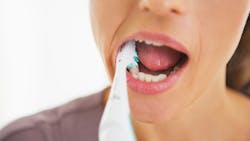Dental plaque prevention and the Bass toothbrushing technique
There’s never been a point in our lifetimes when people have been more aware of the spread of infectious disease. Disease awareness, spread, and prevention are at the forefront of public awareness. Infectious disease is defined by the Mayo Clinic as illnesses and disorders caused by bacteria, fungi, and parasites.1 So by definition, cavities, also called dental caries, and periodontal disease fall under this category.
When it comes to dental disease, we look to prevention as the key to decreasing disease risk and mitigating its spread, and we’ve identified plaque as our enemy. Our mission should be focused around removing plaque and inhibiting bacterial growth in the oral cavity.
A brief look at the oral bacterial population reveals more than 700 bacterial species within the oral cavity.2 The oral microbiome is the community of microorganisms that reside in the oral cavity.3 These bacteria colonize and grow on hard and soft surfaces in the mouth, including the tongue, teeth, gum tissue, cheeks, sulcus, and the palate, causing cavities, gingivitis, and periodontal disease.
The gingival sulcus is the space surrounding the tooth, and it’s is where the tooth and gums come together. There are epithelial or skin cells at the base of the sulcus that adhere the gingival tissue to the surface of the tooth, and bacteria can colonize within the sulcular space. If plaque isn’t removed properly and regularly, it can lead to a condition called gingivitis.
Gingivitis is a common form of gum disease that should be taken seriously as it could lead to more serious periodontal issues and tooth loss. Common symptoms include swollen, dark red gums, bleeding when brushing or flossing, and bad breath. The best way to eliminate gingivitis is to see your hygienist or dentist for thorough professional cleanings. They have the ability to eliminate harmful disease-causing bacteria above and below the gumline, and set you on the right course to good oral health. Between dental visits, you can maintain optimum dental health by brushing and flossing to remove the bacteria before they migrate below the gumline.
Many dental professionals recommend the Bass toothbrushing technique.4 In this method, the toothbrush is placed at a 45-degree angle to the gumline and moved back and forth in short strokes. This removes plaque bacteria on the surface of the teeth and gums, as well as a few millimeters below the gumline. The goal is to protect the gums from inflammation, and worse, bone loss.
With more than 80% of the American population using a manual toothbrush5 and another 80% with periodontal disease, it’s clear that something isn’t working with our current protocols. Effective brushing does not lie in a debate between electric versus manual toothbrushes; studies prove that manual toothbrushing, if performed correctly, is as effective as power-driven toothbrushes.6
The real question is: Are we using our toothbrushes correctly? One of the greatest challenges lies in determining if the toothbrush is, in fact, placed in correct proximity to the gumline.
Based on clinical observation and scientific evidence, a hygienist and dentist set out to create a manual toothbrush that would take the guesswork out of knowing whether or not the toothbrush was placed correctly. The Grippi toothbrush is a manual brush with smart mark indicators that confirm proper bristle placement at a 45-degree angle to the gumline. This simple yet profound design ensures the Bass technique is being properly performed, and retrains people from brushing inadequately to proficiently removing plaque.
Whether you use a manual or electric toothbrush, utilizing the Bass toothbrushing method at least twice a day between professional cleanings is your most powerful weapon in preventing oral disease. By partnering together with your dental provider, you have the power to destroy infectious dental disease, through the power of prevention.
REFERENCES
- Mayo Clinic. Infectious disease symptoms and causes. July 17, 2019. https://www.mayoclinic.org/diseases-conditions/infectious-diseases/symptoms-causes/syc-20351173#:~:text=Infectious%20diseases%20are%20disorders%20caused,passed%20from%20person%20to%20person
- Aas AJ, Paster BJ, Stokes LN, Olsen I, Dewhirst FE. Defining the normal bacterial flora of the oral cavity. J Clin Microbiol. 2005;43(11):5721-5732. doi:10.1128/JCM.43.11.5721-5732.2005
- Deo PN, Deshmukh R. Oral microbiome: Unveiling the fundamentals. J Oral Maxillofac Pathol. 2019;23(1): 122-128. doi:10.4103/jomfp.JOMFP_304_18
- Janakiram C, Varghese N, Venkitachalam R, Joseph J, Vineetha K. Comparison of modified Bass, Fones and normal toothbrushing technique for the efficacy of plaque control in young adults. J Clin Exp Dent. 2020; 12(2): e123–e129. doi:10.4317/jced.55747
- Deery C et al. The effectiveness of manual versus powered toothbrushes for dental health: a systematic review. J Dent. 2004;32(3):197-211. doi:10.1016/j.jdent.2003.11.006
- Vibhute A, Vandana, KL. The effectiveness of manual versus powered toothbrushes for plaque removal and gingival health: A meta-analysis. J Indian Soc Periodontol. 2012;16(2):156-60. doi:10.4103/0972-124X.99255
